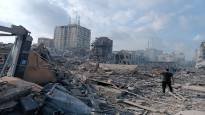– For civilians, the situation is hellish. We must remember that more than half of Gaza’s population are minors.
This sums up the situation of civilians in Gaza Olli Ruohomäki.
Ruohomäki is a visiting leading expert at the Foreign Policy Institute and has worked in the Palestinian territories.
UNRWA, the UN organization helping Palestinian refugees evaluate on Thursday in a report that more than 340,000 people have been forced to flee their homes in Gaza since the unrest between the terrorist organization Hamas and Israel began on Saturday.
About 2.3 million people live in the Gaza Strip.
You can see from the map below that this number of people only lives in an area slightly larger than Espoo.
According to UNRWA, the vast majority of those who fled their homes have sought shelter in schools established by the UN, of which there are 92 in the Gaza Strip. People have sought refuge in schools thinking that Israel would not attack them.
According to Ruohomäki, however, these targets have been hit before in the Gaza wars.
– I know that now at least two UN schools have already been damaged by Israeli airstrikes.
UNRWA released on Tuesday report confirms Ruohomäki’s information. According to the organization, according to current information, 33 people have been injured in airstrikes on or near schools and have had to leave their homes.
On this map you can see where the schools in Gaza are located.
The fact that people are seeking shelter in public spaces speaks to the fact that there is no infrastructure designed for the protection of civilians in the area, says Ruohomäki.
– There aren’t many places to go. People would not seek shelter in schools, hospitals, mosques and other public spaces if there were bomb shelters in the area.
The Israeli blockade worsens the situation for civilians even more
On Monday, Israel’s defense minister Yoav Gallant ordered a “total blockade” of Gaza. Gallant declared that there is no electricity, food, water or gas going to Gaza.
The situation will lead to a huge humanitarian crisis, says Ruohomäki.
– People must have water to drink and food to eat. When there is no electricity and no water, there will be problems. So how, for example, do hospitals work? The principles of international humanitarian law are being tested.
According to UNRWA, there are already more people in temporary shelters than they can actually accommodate, and their food and water reserves are dwindling. Due to the Israeli blockade, no vital supplies can be brought into Gaza.
Only eight of UNRWA’s 22 hospitals are able to provide treatment. Due to dwindling fuel stocks, hospitals may have to be closed in the coming days, the organization estimates.
Ruohomäki sees that the only way to help Gaza’s civilians is through a humanitarian corridor, which allows the international community to deliver essential supplies to the region.
On Tuesday, the World Health Organization WHO demanded an end to the violence and the opening of a humanitarian corridor to the Gaza Strip so that aid can be delivered to civilians.
Egypt does not want millions of refugees in its country
Spokesman for the Israeli Armed Forces Richard Hecht on Tuesday urged Palestinians to flee the Gaza Strip to Egypt through the Rafah border crossing. A little later, the armed forces corrected Hecht’s statement by saying that the border post is closed. The opening hours of the Rafah border crossing with Egypt have varied daily.
In reality, people have no chance to leave Gaza, says Ruohomäki.
– The strip is blocked by Israel from land, sea and air. There are few places to go, Ruohomäki says. He adds that neighboring Egypt does not want millions of Palestinian refugees in its country.
The Egyptian authorities already warned on Monday not to direct the civilians of Gaza towards the Egyptian border. Egyptian officials also condemned Israel’s demands for the mass transfer of civilians from the Gaza Strip across the border to Egypt.
Violence feeds the cycle of revenge
Ruohomäki believes that the suffering experienced by the civilian population of Gaza will cause a collective trauma that may cause more violence in the future.
– Once again, insane hatred and a desire for revenge are being sown. Violence begets violence, Ruohomäki says and adds that the lack of a political solution can lead to a dead end.
– If there is no political way out of the situation, and there is no vision of how to move forward, this will not stop here.
Ruohomäki reminds that over the years both parties have always struck harder than before.
– At some point, the situation will explode again. Over the years, the odds of the conflict have always increased – each time it hits harder.
